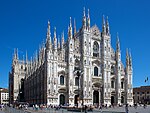Royal Palace of Milan

The Royal Palace of Milan (Italian: Palazzo Reale di Milano) was the seat of government in the Italian city of Milan for many centuries. Today, it serves as a cultural center and it is home to international art exhibitions. It spans through an area of 7,000 square meters and it regularly hosts modern and contemporary art works and famous collections in cooperation with notable museums and cultural institutions from across the world. More than 1,500 masterpieces are on display annually. It was originally designed to include two courtyards but these were later dismantled to make room for the Duomo. The Palazzo is located to the right of the Duomo's facade, opposite to Galleria Vittorio Emanuele II. The facade of the Palazzo creates a recess in Piazza del Duomo which functions as a courtyard, known as the Piazzetta Reale (literally, a "Small Royal Square"). The famous Hall of Caryatids can be found on the main floor of the building, heavily damaged by World War II's air raids. After the war the Palazzo remained abandoned for over two years and its condition further deteriorated. Many of the Palazzo's neoclassical interiors were lost in this period.
Excerpt from the Wikipedia article Royal Palace of Milan (License: CC BY-SA 3.0, Authors, Images).Royal Palace of Milan
Small Royal Square, Milan Municipio 1
Geographical coordinates (GPS) Address Nearby Places Show on map
Geographical coordinates (GPS)
| Latitude | Longitude |
|---|---|
| N 45.4632 ° | E 9.1911 ° |
Address
Surveillance camera
Small Royal Square
20122 Milan, Municipio 1
Lombardy, Italy
Open on Google Maps









